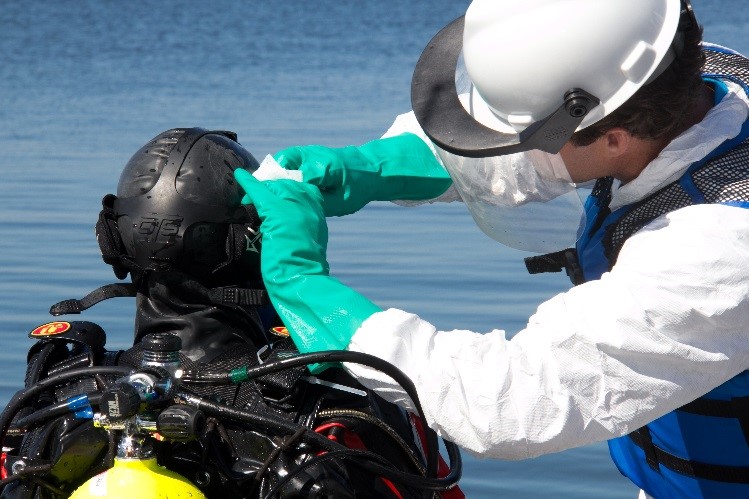Over 30 years of Wyckoff Superfund Site Diving Science
By Sean Sheldrake

Very early efforts to characterize the Wyckoff Superfund site. Like the cleanup, dive gear and protocols have evolved a great deal since this photo was taken in 1985.
If you’ve followed our previous blog posts about EPA’s scientific diving program, you may know the program dates back to the very beginning of the Agency. What you may not know is that EPA underwater scientists have also been supporting the Superfund program since its beginning in the early 1980s. In this installment we talk about the long term involvement of underwater scientists in taking a Superfund site from contaminated to clean – and keeping it that way. This is how science made the difference in Washington’s Puget Sound.
The first step.
Wood treating operations at the Wyckoff Superfund site in Washington’s Puget Sound have a long history that resulted in substantial soil, groundwater, and Puget Sound sediment contamination. Divers were instrumental in documenting the problems on Bainbridge Island, and were involved in early mapping efforts to locate the worst of the contamination on the bottom of Puget Sound.
The first step was finding all the contamination on the bottom, and identifying particularly problematic areas that might require more aggressive cleanup options.
Diving at Superfund sites is “dirty diving” and requires special methods on the boat, and medical monitoring on a regular basis. Divers must be trained in how to properly protect themselves with the right types of gear, including a drysuit that keeps them completely isolated from the dive environment. In addition, they must carry out decontamination steps to fully clean the gear after each dive, so they don’t risk exposing themselves or the boat crew. In one dive in 1997, I can remember being very edgy about maintaining my buoyancy as I looked down upon my reflection in one of many of these creosote pools – it was like being inside of a lava lamp full of highly toxic chemicals.
How bad is it?
Some of the worst areas where pools of creosote were documented had to be completely removed, versus capped with clean material in place. During these early dives in the 1980s and 1990s, divers reported seeing dead crab littering the bottom with obvious cancer tumors from exposure to the polyaromatic hydrocarbons present in the creosote.
Why not use contractors?
While some underwater science necessary to make EPA cleanup decisions can be delegated to contractors, many underwater tasks take substantial training and technique to perform in a manner that will obtain quality data. Ensuring that EPA diving scientists are involved from the early stages of sampling planning through collection ensures that the data will be of high quality and meet the project manager’s decision making needs.

EPA underwater scientist Brent Richmond takes a surface sediment sample. Photo by Sean Sheldrake, USEPA.

EPA divers sample the outfall from the Wyckoff groundwater treatment plant to ensure it meets cleanup standards and is protective of Puget Sound.

EPA diver Brent Richmond installs a passive sampler into the seafloor in 2013 to evaluate whether low levels of contamination exist in the pore spaces that could hurt bottom dwellers. This information was later used to determine that the east beach area required cleanup similar to areas within Eagle Harbor near the Wyckoff Site. Photo by Sean Sheldrake, USEPA.
Did the cleanup work?
As a diver that was involved in the early cleanup and also monitoring to make sure it is still protecting wildlife, I find the Wyckoff site almost unrecognizable. A flurry of bottom fish and crab are present at every turn, where before it was virtually a dead zone.
Is it still working?
We can’t stop now! EPA divers continue to dive at the Wyckoff site to investigate areas where cleanup fixes might be needed, such as the east beach area, where additional cleanup was proposed based on underwater samples showing contamination. Ongoing sampling work is necessary where waste is left in place to make sure the cleanup is still functioning as designed.
Then and now
While diving equipment and protocols have certainly evolved over the past 30 plus years of Wyckoff cleanup, underwater science has been an ever present part of making decisions upon good data throughout.
EPA divers will continue to be at the ready for the next 30 years to provide good scientific data for EPA’s Superfund cleanup program and to ensure the protection of people and wildlife.
For more information on the Wyckoff cleanup, watch the video Wyckoff Eagle Harbor Superfund Cleanup.
Read more about the latest in EPA scientific diving on the EPA Divers Facebook page.
EPA divers have a new website!
About the author: Sean Sheldrake is a 19 year veteran of the Seattle EPA Dive unit and is also a project manager working on the Portland Harbor cleanup in Oregon. Sean Sheldrake serves on the EPA diving safety board, responsible for setting EPA diving policy requirements. In addition, he works to share contaminated water diving expertise with first responders and others.







